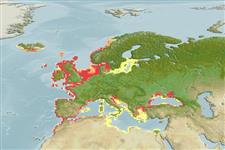Environment: milieu / climate zone / depth range / distribution range
Ekologi
marina bottenlevande; havsvandrande (Ref. 51243); djupintervall 5 - 50 m (Ref. 6302). Temperate; 64°N - 26°N, 24°W - 42°E
Eastern Atlantic: 68°N to Morocco. Reported from Iceland (Ref. 12462). Also known throughout the Mediterranean and Black Sea.
Length at first maturity / Size / Vikt / Age
Maturity: Lm 37.0, range 33 - 41 cm
Max length : 75.0 cm TL hane/ej könsbestämd; (Ref. 35388); common length : 30.0 cm TL hane/ej könsbestämd; (Ref. 3397); publicerad maxvikt: 8.0 kg (Ref. 35388); rapporterad maxålder: 6 år (Ref. 38118)
Thinner and more slender body. Skin with small, smooth scales, without bony tubercle. Able to change color of the eyed side, matching the bottom they rest on. Color is often olive green, with dark and light spots (Ref. 35388).
Lives on sandy or mixed bottoms; feeds on bottom-living fishes and larger crustaceans. Marketed fresh and frozen; eaten steamed, fried, broiled, boiled, microwaved and baked (Ref. 9988).
Life cycle and mating behavior
Könsmognad | Reproduktion | Lek | Ägg | Fecundity | Larver
Bauchot, M.-L., 1987. Poissons osseux. p. 891-1421. In W. Fischer, M.L. Bauchot and M. Schneider (eds.) Fiches FAO d'identification pour les besoins de la pêche. (rev. 1). Méditerranée et mer Noire. Zone de pêche 37. Vol. II. Commission des Communautés Européennes and FAO, Rome. (Ref. 3397)
IUCN Red List Status (Ref. 130435: Version 2024-2)
Threat to humans
Harmless
Human uses
Fiskeri: kommersiell; sportfisk: ja
Verktyg
Special reports
Download XML
Internet-källor
Estimates based on models
Preferred temperature (Ref.
123201): 8.4 - 19.5, mean 11.2 °C (based on 472 cells).
Phylogenetic diversity index (Ref.
82804): PD
50 = 0.5645 [Uniqueness, from 0.5 = low to 2.0 = high].
Bayesian length-weight: a=0.01096 (0.00893 - 0.01346), b=3.01 (2.95 - 3.07), in cm total length, based on LWR estimates for this species (Ref.
93245).
Trofisk nivå (Ref.
69278): 4.4 ±0.1 se; based on diet studies.
Generation time: 4.1 ( na - na) years. Estimated as median ln(3)/K based on 2
growth studies.
Resiliens (Ref.
120179): Mellan, lägsta populationsfördubblingstid 1,4-4,4 år (tm=-5; tmax=6).
Prior r = 0.47, 95% CL = 0.31 - 0.70, Based on 5 full stock assessments.
Fishing Vulnerability (Ref.
59153): Moderate vulnerability (36 of 100).
Climate Vulnerability (Ref.
125649): Moderate to high vulnerability (54 of 100).
Nutrients (Ref.
124155): Calcium = 37.7 [14.9, 70.5] mg/100g; Iron = 0.174 [0.061, 0.770] mg/100g; Protein = 19.3 [17.8, 20.8] %; Omega3 = 0.262 [0.140, 0.491] g/100g; Selenium = 14 [6, 33] μg/100g; VitaminA = 8.74 [1.87, 40.75] μg/100g; Zinc = 0.145 [0.082, 0.500] mg/100g (wet weight); based on
nutrient studies.
